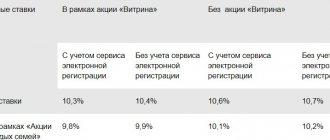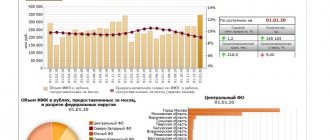Assessing the reality of the chances of obtaining a mortgage loan is what a preliminary real estate assessment is for. Let us consider the essence of this issue in more detail. Perhaps the most risky undertaking for both parties, that is, for both the bank and its client, is mortgage lending. The borrowed amount amounts to hundreds of thousands of rubles, sometimes even millions, and the bank, of course, must do everything to minimize its risks. Moreover, a truly good bank will try to minimize risks for the borrower.
Property valuation
Main risks of loan non-repayment
The main risk in this case is the possible non-repayment of the loan . And here the organization providing lending services wants to be confident in the liquidity of the real estate pledged as collateral. In other words, residential or non-residential premises, a building, against which a loan was taken as collateral, and which, in the event of the borrower’s insolvency, by a court decision becomes the property of the bank, must be easily sold, and at a price that allows the bank to cover the costs of the unrepaid loan. The bank seeks to obtain real estate as collateral with a value adequate to the amount issued on credit. And understanding this desire explains why the bank and the borrower need a real estate appraisal. Property valuation is a key factor that is taken into account when deciding whether to issue a loan. Moreover, this procedure has been included in the current legislation of Russia.
Why do you need a property valuation?
Who conducts the assessment
Real estate assessment can only be carried out by a qualified expert appraiser - then the report will be accepted by the bank or government agencies. If a real estate agency asks you to appraise a property, check to see if they have a state license to do so, or if “appraisal” refers to a subjective opinion about the relative value of the property.
Distinctive features of a professional appraisal company:
- There is a certificate of participation in the SRO - this is a non-profit professional association that regulates the actions of appraisers;
- There is civil liability insurance for the expert himself;
- The expert concludes an agreement and does not hide the details of the organization. The contract clearly states that a real estate valuation service is being ordered. There are no vague formulations like “information” or “marketing” services.
- The company cares about its reputation; there are positive reviews from real customers.
Who is a real estate appraiser?
An independent appraiser is invited to perform the assessment and provides a report based on the results of his work. This report serves as a starting point in the bank’s decision-making process on whether to issue the borrower the amount he needs. Based on the results of studying the report, the final loan amount and the amount of interest on the loan will be determined. In addition, a report is sent to the insurance company. After all, real estate registered as collateral must certainly be insured. At the same time, the insurer also determines whether the value of the home corresponds to the amount borrowed. The report compiled by an independent appraiser contains information on the so-called liquidation and market values of the home. Liquidation value allows you to analyze the situation with the borrower's insolvency and make a fairly accurate assumption about what price the apartment can be sold for urgently. Market value represents the real value of real estate, that is, the amount that can be obtained by selling it on the market without losses associated with the urgency of the sale. The difference between these two types of value is approximately 25-30%, and when studying the appraiser’s report, banks are more interested in the liquidation value, because it is this value that reflects the most likely amount that the bank can receive, and in a short time.
How to evaluate real estate according to the new rules
What methods are used?
To establish the value of a property, it can be compared with other properties. This is most often done in relation to residential apartments or houses.
If we are talking about commercial real estate, then you need to use the income method. It allows you to determine how much you can earn per square meter of an object. And you can already build on this.
The choice of a specific cost determination method depends on the object. The selection is carried out by a specialist who takes into account all the available nuances. He can always justify his approach to evaluating a particular building.
Why do you need a real estate appraisal?
It is difficult for a borrower to understand the influence of a variety of factors on the final cost, much less translate this influence into a monetary equivalent, so he does not ask the question “Why is a real estate appraisal needed?” An independent appraiser will be able to take into account a lot of criteria, such as: - The first thing that is taken into account when assessing is the location of the apartment. In almost any city in the world, the cost of an apartment in the city center seriously exceeds the cost of exactly the same one, but located somewhere in residential areas, on the edge of the city. Part of the same criterion is the level of development of the area’s infrastructure, the presence nearby of social institutions such as kindergartens, clinics, hospitals, as well as shops and recreational facilities.
- The condition of the house is of great importance. The apartment can be located in a standard “Khrushchev” or “Stalin” building, it can be part of a new elite building or a relatively old panel high-rise building. It is important to know what the house in which the apartment is located was built from. Housing in a brick house will differ in cost from an apartment in a panel or monolith. In addition, the degree of wear and tear of the house plays an important role, as well as the presence of additional options, such as underground garages or parking, an elevator, a garbage chute, security, a concierge, even the number of floors of the house.
- The appraiser will also take into account the transport component. For some citizens, it is important that the road from home to work can be reached on foot, for others - that there is a public transport or metro stop within a 1-2 minute walk. For others, the convenience of getting from the yard to the highway using their own transport is no less important. With all this, the negative impact of such components as the proximity of transport interchanges or railways, tram tracks or even airports is also taken into account. The listed disadvantages can greatly affect the cost of the apartment towards its reduction.
- Housing parameters will also be taken into account. Here the floor comes first. For many reasons, our country has developed a negative attitude towards the first and last floors. The cost of such apartments compared to similar ones on other floors will be slightly lower. The area of the apartment, both total and residential, type of layout, number of rooms, condition and type of bathroom, presence or absence of balconies and loggias are also important. What matters is the side on which the apartment’s windows face, the view from these windows, and the location of the apartment in the house (corner or middle). A detailed study of all these criteria by a specialist in this field and the preparation of a report that actually reflects the cost of housing - who needs an assessment of real estate left as collateral. Only under such conditions will the bank be able to determine the exact amount of the amount that it can issue to its client.
Professional assessment
If the previously carried out assessment procedures do not satisfy the owner, or he needs to reach a deal as quickly as possible, he can turn to independent experts. They take into account the same factors as described earlier.
Before concluding a contract with the contractor, it is worth discussing the following points separately:
- Payment by the customer;
- Total cost of services;
- Availability or absence of information required to obtain the result;
- The value used in certain circumstances;
- Purpose of the procedure;
- Description of the property requiring appraisal.
The stages of service provision will look like this:
- First, negotiations are held with the contractor;
- The timing of the event is determined;
- A specialist travels to the address;
- Drawing up an inspection report for the facility;
- The customer submits his documents;
- Collection of missing information;
- The specialist studies materials;
- Determining the assessment option;
- Calculation of housing prices;
- Drawing up an assessment report based on the results of the work.
When the contract is concluded, a specific moment is chosen when the specialist will leave. It rarely takes more than half an hour to inspect the premises. For assessment purposes, specialists examine and analyze all market segments to which the property belongs.
What law regulates the cost of apartments?
Federal assessment standards, as well as No. 135 Federal Law, are the main documents on which the specialists themselves rely when carrying out work. FSO No. 1 is another basis for the assessment. Ordinary citizens can also use it.
What it is
First, let's look at the general definition. Market value of real estate is the determined price that a buyer is willing to pay for real estate according to market principles . The value of the property may be inflated. For example, in the city center.
Or sold almost at cost. For example, on the outskirts of the city, where transport communications are not so developed. Of course, there are a number of nuances, but in general terms this is true . In practice, there are a number of conditions characteristic of market value. Let's list some of them:
- Both parties (buyer and seller) are equally interested in purchasing the property. Any pressure that influences making an informed decision to sell or buy is eliminated.
- Both parties are well informed about the state of the market at the moment and negotiate based on their own interests.
- Both sides are not making big concessions on the money issue.
There is an opinion that the value of real estate can be determined using a technical passport. But it is not always the case. The cost can also be indicated in the documents of Rosreestr or BTI. But, as a rule, all prices in such documents are indicative.
They are intended to guide and give a first idea of the real value of the property. In addition, the real value of the object may be outdated.
IMPORTANT! The real estate market is a rather dynamic environment, where prices change depending on a number of factors - time of year, distance from the city center, dollar exchange rate, economic situation in the country.
The assessment of the market value of real estate is usually carried out by specialized organizations that use complex methods to determine and provide customers with an official document indicating the current real value of the presented real estate.
The state regulates the assessment process in Federal Law 135 of 1998. Moreover, real estate assessment is sometimes carried out without fail.
This applies to cases when a property by right of alienation goes to the state or its subject. In other cases, the assessment of market real estate is purely voluntary.
In what cases may a real estate valuation be required? Let's look at a few common cases:
- sale or purchase of real estate (especially relevant for organizations);
- real estate insurance;
- loan secured by real estate. The bank is interested in the exact cost of the apartment or house;
- litigation regarding the division of property between spouses or relatives;
- the citizen enters into inheritance.
How much does a real estate appraisal cost in Krasnodar?
When planning to contact an appraisal company, most customers are primarily interested in prices. Understanding this, we pursue a customer-loyal policy that allows us to provide not only high-quality, but also inexpensive services. The amount in the contract depends on the area and other characteristics of the object, but in any case remains low. Below on this page of the site there is a table with tariffs. After reading it, you can be convinced of the availability of independent expertise.
| № | Name of service | Cost, rub. | Duration, days |
| 1 | Apartment valuation | from 3000 rub. | 1-3 |
| 2 | Room examination | from 2500 rub. | 1-3 |
| 3 | Home valuation | from 6000 rub. | 5-10 |
| 4 | Examination of a land plot | from 4000 rub. | 1-3 |
| 5 | Commercial real estate valuation | from 10,000 rub. | 5-10 |
| 6 | Examination of cadastral value | from 15,000 rub. | 5-10 |
Do you want to order an inexpensive real estate appraisal? Contact us by phone
Types of value of valuation objects. Methods and approaches to assessment
The Law on Valuation Activities (Article 7) establishes the assumption of determining the market value of the valuation object. This rule means that if a normative legal act containing a requirement for a mandatory assessment, or an agreement on the assessment of an object being assessed, does not define a specific type of value of the object being assessed, it is the market value of this object that is subject to determination. It should be borne in mind that this rule also applies in the case of the use in a normative legal act of terms not provided for by the Law on Valuation Activities or Valuation Standards that define the type of value of the object of evaluation, including “true value”, “reasonable value”, “real value” " and etc.
The market value of the valuation object is understood as the most probable price at which this object can be alienated on the open market in a competitive environment, when the parties to the transaction act reasonably, having all the necessary information, and the value of the transaction is not affected by any extraordinary circumstances.
By the absence of emergency circumstances, the Law understands the presence of the following conditions:
- one of the parties to the transaction is not obliged to alienate the object of valuation, and the other party is not obliged to accept execution;
- the parties to the transaction are well aware of the subject of the transaction and act in their own interests;
- the valuation object is presented on the open market through a public offer, typical for similar valuation objects;
- the transaction price represents a reasonable remuneration for the object of valuation, and there was no coercion on the part of the parties to enter into the transaction;
- payment for the valuation object is expressed in monetary form.
In addition to market value, the following types of value are used (their list and definition are given in clause 4 of the Valuation Standards):
- the value of an appraisal object with a limited market is the value of an appraisal object, the sale of which on the open market is impossible or requires additional costs compared to the costs necessary for the sale of goods freely circulating on the market;
- replacement cost of the appraisal object, the amount of costs for creating an object similar to the appraisal object, in market prices existing on the date of the appraisal, taking into account the depreciation of the appraisal object;
- cost of reproduction of the valuation object - the sum of costs in market prices existing on the date of valuation, for the creation of an object identical to the valuation object, using identical materials and technologies, taking into account the wear and tear of the valuation object;
- the value of the appraised object under existing use is the cost of the appraised object, determined on the basis of existing conditions and the purpose of its use;
- investment value of the valuation object - the value of the valuation object, determined based on the profitability for a specific person for given investment goals;
- the value of an appraised object for tax purposes is the value of an appraised object, determined for calculating the tax base and calculated in accordance with the provisions of regulatory legal acts (including inventory value);
- liquidation value of the valuation object - the value of the valuation object if it must be alienated in a period shorter than the usual period of exposure of similar objects (i.e., the period of time starting from the date the object is presented on the open market until the date of the transaction with it);
- disposal value of the appraisal object - the value of the appraisal object, equal to the market value of the materials it includes, taking into account the costs of disposal of the object;
- special value of the valuation object - a value for the determination of which the valuation agreement or regulatory legal act stipulates conditions that are not included in the concept of market or other value specified in the Valuation Standards.
An analogue of the valuation object is another object similar in basic economic, material, technical and other characteristics to the valuation object, the price of which is known from a transaction that took place under similar conditions.
The valuation method is understood as a method for calculating the value of the valuation object within the framework of one of the approaches to it. approaches to assessment are distinguished
- cost approach - a set of methods for assessing value based on determining the costs necessary to restore or replace the object of assessment, taking into account its wear and tear;
- comparative approach - a set of valuation methods based on comparison of the valuation object with similar objects for which there is information on the prices of transactions with it;
- income approach - a set of valuation methods based on determining the expected income from the valuation object.
When assessing an object, the appraiser selects the assessment method(s) within each of the assessment approaches. At the same time, he is obliged to use (or justify the refusal to use) all the previously mentioned approaches to assessment. The appraiser has the right to independently determine specific assessment methods within each assessment approach.
Based on the results obtained within each approach to evaluation, the appraiser determines the final value of the object being assessed. It represents the result of a generalization, justified by the appraiser, of the results of calculations of the value of the property being assessed using various approaches to valuation and valuation methods.
What does a real estate appraisal report look like?
The finished appraiser's report looks like a stack of A4 sheets - about 20-30 pages. Each one is numbered, all filed in one folder. There is a signature on each sheet.
The main part is the final part, it indicates the market value of the property.
The report must also contain information about the customer and contractor. Attached are photographs of the object.
Please note - for example, if a report was ordered to obtain a mortgage and provide documents to the bank, both the market and liquid value must be indicated in the final part. Read more about the types of costs in the section below.
The data in the report is written in accordance with GOSTs and the requirements of regulatory documents. The area, characteristics of the object, number of floors, layout and other data are indicated. The expert supplements the report with data on the condition of the property, information on the proximity of the property to social infrastructure and the condition of the local area.








